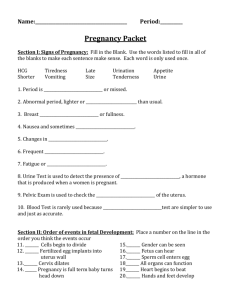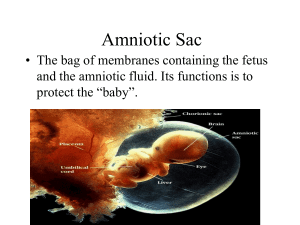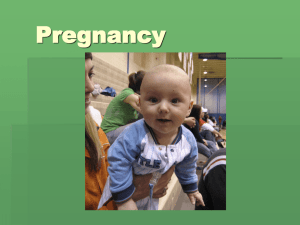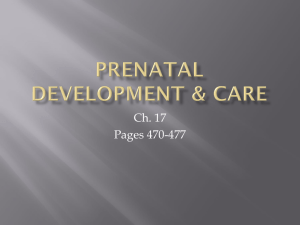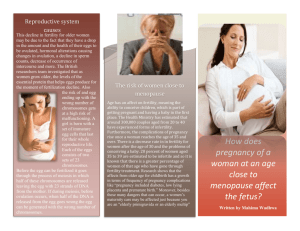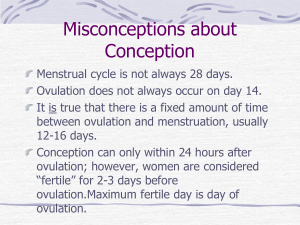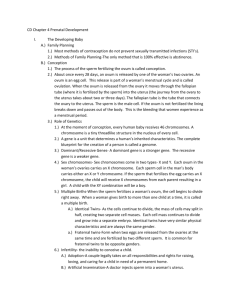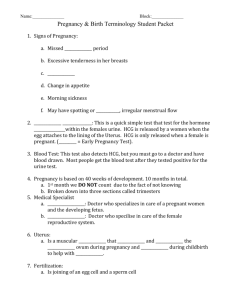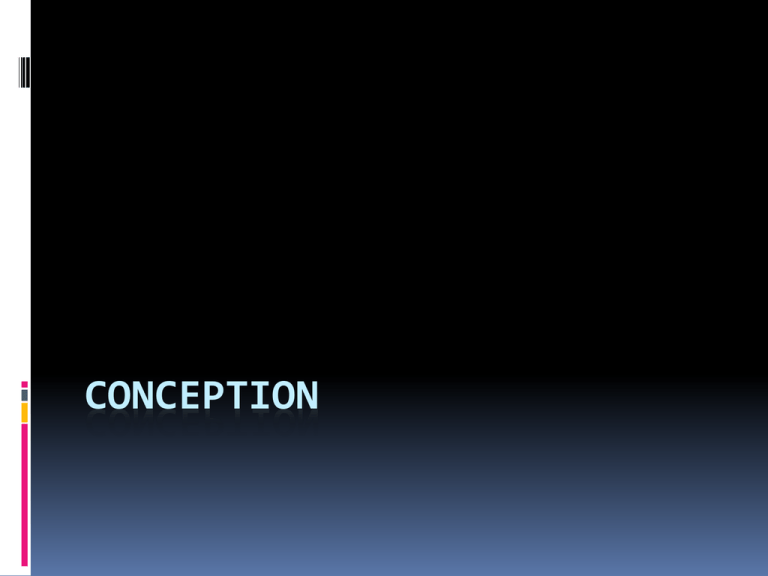
CONCEPTION
Egg & Sperm Cells
Egg Cell: Same as “ovum”… the cell from a
girl or woman that can start pregnancy.
Sperm Cell: The cell from a boy or man that
can start pregnancy when joined with an
ovum.
Each cell has 23 chromosomes.
Ovulation
Egg & Sperm Cells
http://www.saburchill.com/images02/020107032.jpg
http://www.saburchill.com/images02/020107031.jpg
Fertilization
Fertilization: the joining
of a sperm and an ovum.
Fertilized egg: What an
ovum is called after the
chromosomes from a
sperm have mixed with
the ovum’s
chromosomes.
http://worms.zoology.wisc.edu/dd2/echino/fert/files/page19_2.gif
The Voyage of Sperm
The Growing baby…
Implantation: The ball of
Implantation cells (that used to be a
single fertilized egg) nesting
in the wall of the uterus.
Fertilization & Implantation
= Conception
Conception: The beginning
of a pregnancy.
http://2.bp.blogspot.com/_UdOhpj0rJJo/THcSyYF3gsI/AAAAAAAAAi8/
Zmk3xBOTV2I/s1600/getty_rm_illustration_of_egg_implanting_in_uter
us.jpg
After they meet
Gender
Determined by two sex chromosomes.
Girl - XX
Boy – XY
Each parent gives one chromosome.
One is always X because moms only have X’s.
The dad can give either X or Y.
This determines whether a boy or girl.
Multiple Births
Identical Twins: Twins that
grow from one egg,
fertilized by one sperm, that
split into two balls of cells
before it implanted in the
uterus. They have the same
genes, so they look exactly
alike.
http://ww
w.dptips
central.c
om/imag
efiles/dian
e_arbus
_identic
al_twins
_1967.jp
g
http://upload.wikimedia.org/wikipedia/en/7/7e/Identical-fraternal-spermegg.png
Multiple Births
Fraternal Twins: Twins
that grew from two
eggs, each fertilized by
a different sperm. They
don’t look any more
alike that any brothers
and sisters because they
have different genes.
http://upload.wikimedia.org/wikipedia/en/7/7e/Identical-fraternal-spermegg.png
Pregnancy
A woman is pregnant when she’s going to
have a baby.
Amniotic Sac: The thin membrane (like the
skin inside the shell of a chicken egg) that
surrounds the amniotic fluid and fetus.
http://www.camberwellultrasound.com.au/photos/amn.jpg
Pregnancy
Fetus: The developing baby from about 10
weeks to birth.
Before that, it is called an “embryo”.
- the main difference is the
placenta.
http://leaveofabsinthe.files.wordpress.com/2010/01/15weekfetus1.jpg
Becoming an Embryo
Boy or Girl? Embryo to Fetus
http://www.aurorahealthcare.org/yourhealth/healthgate/images/si55550962.jpg
Pregnancy
Placenta: An organ that
grows inside the uterus
during pregnancy to carry
food and oxygen from the mother and waste
from the embryo or fetus.
It produces many hormones that affect both the
mother and the baby.
It develops from the original ball of cells that
implanted in the uterus.
NEXT IMAGE IS GRAPHIC! DON’T LOOK
IF YOU HAVE A WEAK STOMACH!
Placenta
http://apusa.us/wp-content/uploads/2011/01/Placenta.jpg
Food Bones and Sound
Pregnancy
Umbilical Cord: the tube leading from the
navel of the embryo or fetus to the placenta.
It carries food and oxygen to the developing baby
and waste from the developing baby.
http://themomblog.ocregister.com/files/2009/03/umbili
calcordatbirth.jpg
Prenatal
Prenatal: before birth. Prenatal care means
getting special check-ups at least once a month
from a doctor starting as early in a pregnancy as
possible.
Good early care can greatly reduce the risks of
birth defects, low birth weight, or prematurity.
It also helps keep the mother healthy.
Problems
Birth Defects: Anything wrong with a
newborn baby. Cleft pallet, heart problems,
blindness, cerebral palsy, etc.
Miscarriage: A pregnancy ending much too
soon, before the embryo or fetus is able to
live outside the uterus.
Problems
Low Birth Weight: a baby that is “too” small.
Weighs less than 5.5lbs at birth.
A LBW baby is more likely to be sick or have birth
defects.
It is also likely to develop more slowly and to have
more difficulty in school.
It also may turn out healthy and do just fine.
Low Birth Weight Babies
http://thebumpoc.com/wp-content/uploads/spl_low_birthweight_baby7.jpg
Problems
Premature: Born “too” soon. Born fewer than
40 weeks (9 months) of pregnancy.
Depending on how early baby is born a premature
baby may have serious birth defects or problems.
Minor birth defects or problems.
The baby could also have no problems and do just
fine.
http://i.dailymail.co.uk/i/pix/2008/12/12/article-109407202C82396000005DC-451_468x286.jpg
Problems
Pre-Eclampsia & Eclampsia:
- High blood pressure and high protein in
the urine.
- Also marked by swelling of the feet, legs
and hands.
If left undiagnosed can lead to Eclampsia
which puts both mother and baby at risk,
and in rare cases death.

